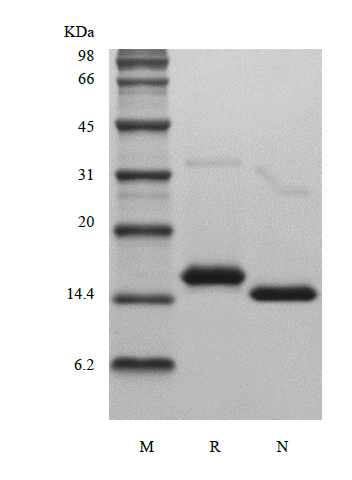- Synonyms
- IL-TIF, IL-TIF alpha, IL-22a
- Source
- Escherichia coli.
- Molecular Weight
- Approximately 16.6 kDa, a single non-glycosylated polypeptide chain containing 146 amino acids.
- AA Sequence
- LPVNTRCKLE VSNFQQPYIV NRTFMLAKEA SLADNNTDVR LIGEKLFRGV SAKDQCYLMK QVLNFTLEDV LLPQSDRFQP YMQEVVPFLT KLSNQLSSCH ISGDDQNIQK NVRRLKETVK KLGESGEIKA IGELDLLFMS LRNACV
- Purity
- > 96 % by SDS-PAGE and HPLC analyses.
- Biological Activity
- Fully biologically active when compared to standard. The ED50 as determined by inducing IL-10 secretion of human COLO 205 cells is less than 0.2 ng/ml, corresponding to a specific activity of > 5.0 × 106 IU/mg.
- Physical Appearance
- Sterile Filtered White lyophilized (freeze-dried) powder.
- Formulation
- Lyophilized from a 0.2 μm filtered concentrated solution in 1 × PBS, pH 7.4.
- Endotoxin
- Less than 1 EU/μg of rMuIL-22 as determined by LAL method.
- Reconstitution
- We recommend that this vial be briefly centrifuged prior to opening to bring the contents to the bottom. Reconstitute in sterile distilled water or aqueous buffer containing 0.1 % BSA to a concentration of 0.1-1.0 mg/ml. Stock solutions should be apportioned into working aliquots and stored at ≤ -20°C. Further dilutions should be made in appropriate buffered solutions.
- Stability & Storage
- Use a manual defrost freezer and avoid repeated freeze-thaw cycles.
- 12 months from date of receipt, -20 to -70 °C as supplied.
- 1 month, 2 to 8 °C under sterile conditions after reconstitution.
- 3 months, -20 to -70 °C under sterile conditions after reconstitution.
- Usage
- This material is offered by Shanghai PrimeGene Bio-Tech for research, laboratory or further evaluation purposes. NOT FOR HUMAN USE.
- SDS-PAGE

- Reference
- 1. Zeng G, Chen CY, Huang D, et al. 2011. J Immunol, 187: 190-9.
2. Cocco CandAiroldi I. 2012. Immunotherapy, 4: 668.
3. Honda K. 2012. Immunity, 37: 952-4.
4. Gurney AL. 2004. Int Immunopharmacol, 4: 669-77.
- Background
- IL-22 is belonging to IL-10 family of regulatory cytokines which includes IL-10, IL-19, IL-20, IL-22, IL-24 and IL-26. Members of this family share partial homology in their amino acid sequences, but they are dissimilar in their biological functions. Produced by T lymphocytes and dendritic cells, IL-10 contributes to the inflammatory response in vivo. IL-22 signals through CRF2-4 and IL-22. It along with IL-17 is rapidly produced by splenic LTi-like cells and can be also produced by Th17 cells. IL-22 likely plays a role in the coordinated response of both adaptive and innate immune systems. Recombinant mouse interleukin-22 contains 147 amino acids and it has approximately 81 % and 92 % amino acid sequence identity with human and rat IL-22.

 COA申请
COA申请
